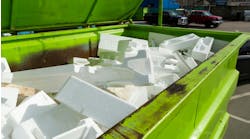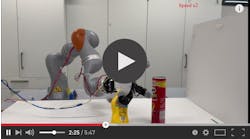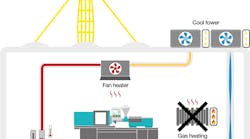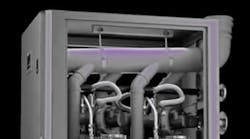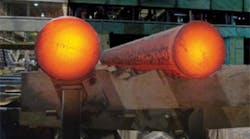Engineers from igus are now using a simple technology for heat recovery. It heats industrial factories with the waste coolant water from machines, saving on gas costs and CO2 emissions. igus is making the technology available online, with all the details available to other industrial companies. If all injection molders worldwide used the technology, over 14 million tons of CO2 and over 7 billion cubic meters of gas could be saved.
Gas prices are rising. Climate change is progressing and it's time to act. igus is already on the way to the goal of climate-neutral production by 2025.
Three engineers have set to work to make the use of fossil fuels superfluous during the production period. To do this, they first experimented with heat exchangers from a car and fans from a computer. The experiments got bigger and more and more square meters could be heated. After six months, the new concept called "Machine Heat Recovery System" (MHRS for short) succeeded in heating one of the large factory halls at the head office in Cologne-Lind with waste heat from the injection molding machines.
Depending on the heating requirement, the MHRS distributes the flow of hot water coming from the cooling circuit directly to the fan heaters while also ensuring that the machines do not overheat. As heat is extracted from the hot water, it passes through the fan heater, decreasing the demand on the cooling tower. This provides the advantage to eliminate former heating methods while using less electric energy for cooling.
The fluctuating cooling circuit temperatures can be variably adjusted by the system. The MHRS does not take a detour via an expensive heat pump and also a heat exchanger is not necessary either, as this would lead to temperature losses. An additional feed of waste heat from air compressors is also not required. igus is already gradually reducing compressed air energy to reduce energy costs.
"With this in-house heating system, we can reduce gas consumption to zero in the future. In addition, we need less electrical energy for cooling," says igus CEO Frank Blase. "We not only save costs but also reduce CO2 emissions, protecting the environment."
How it Works
The hydraulic motors of the injection molding machines heat up during operation. Just like a car, they need cooling to protect them from overheating. Cooling towers are used here, which provide cold water and conduct it to the machines via a pipe system. The heated water returns to the cooling tower. When it's re-cooled, the heat escapes into the atmosphere and is lost as energy.
With the MHRS, some heat from the cooling circuit is captured by a flow control and sent directly to the heaters, which are next to the old gas heater fans. To prevent these heaters from clogging immediately, strainers filter out suspended particles that are in the water. The warm water enters the new fan heater and causes the old fan heater to stop working. A fan on the heater finally distributes the heated air in the hall. Only then does the water flow back to the cooling tower and the cycle begins again. As no heat exchangers are used, the system can also be operated in the low-temperature range.
A Concept for the Industry
"We are so convinced of our concept that we plan to rely entirely on machine heat for heating the factory and office areas in the future," says Dennis Berninger, Factory Manager at igus and the driving force behind this project.
The next plan is to equip the 7,209 square meter logistics center with nine fan heaters. Here alone, around 31.5 tons of CO2 can be saved every year. This is an important step for igus to get closer to the completely CO2-neutral goal for buildings and production by 2025.
Spurred on by the success, igus decided to make the technology available to other industrial companies as well. A conservative calculation finds more than 14 million tons of CO2 and more than 7 billion cubic meters of gas could be saved if all injection molders worldwide were to use this technology. This corresponds to the annual gas consumption of 3.18 million four-person households.
"We see great potential for the MHRS in the industry, which is why we want to make the concept available to other companies free of charge. During our research, we found no published instructions ourselves," says Dennis Berninger. "With our website, we are already providing information on how MHRS and the developed control device work.”
More information about MHRS is available here: https://www.igus.eu/info/heating-concept.


